Application of Accounting Theory in Rio Tinto Mining Corporation
VerifiedAdded on 2023/01/19
|7
|1534
|60
Report
AI Summary
This report analyzes the application of accounting theory within the context of Rio Tinto, a major mining corporation. It begins with an introduction to accounting theory and provides background information on Rio Tinto, including its history, operations, and strategic goals. The study's scope is defined by examining the applicability of sustainability accounting theory and its impact on stakeholders, the environment, and value creation. The report then presents preliminary analysis findings, focusing on how financial statements are used by various stakeholders, including management, investors, lenders, and competitors. The report distinguishes between fixed and flexible balance sheet formats, detailing their characteristics and requirements. The conclusion emphasizes the importance of sustainability accounting for Rio Tinto, recommending the adoption of a fixed format for balance sheets and highlighting the relevance of accounting theories in financial reporting. The report concludes with a list of references including books and journals.
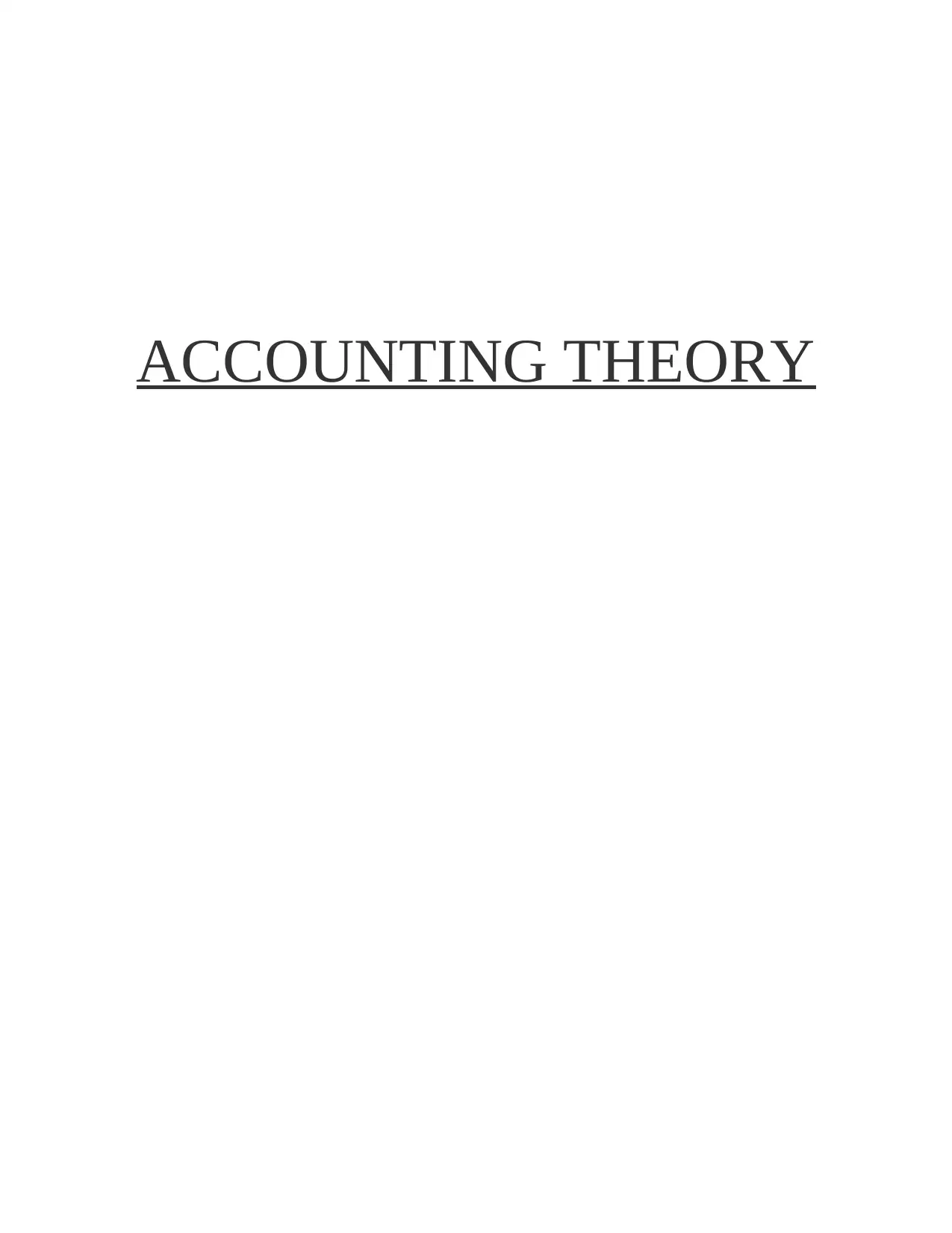
ACCOUNTING THEORY
Paraphrase This Document
Need a fresh take? Get an instant paraphrase of this document with our AI Paraphraser
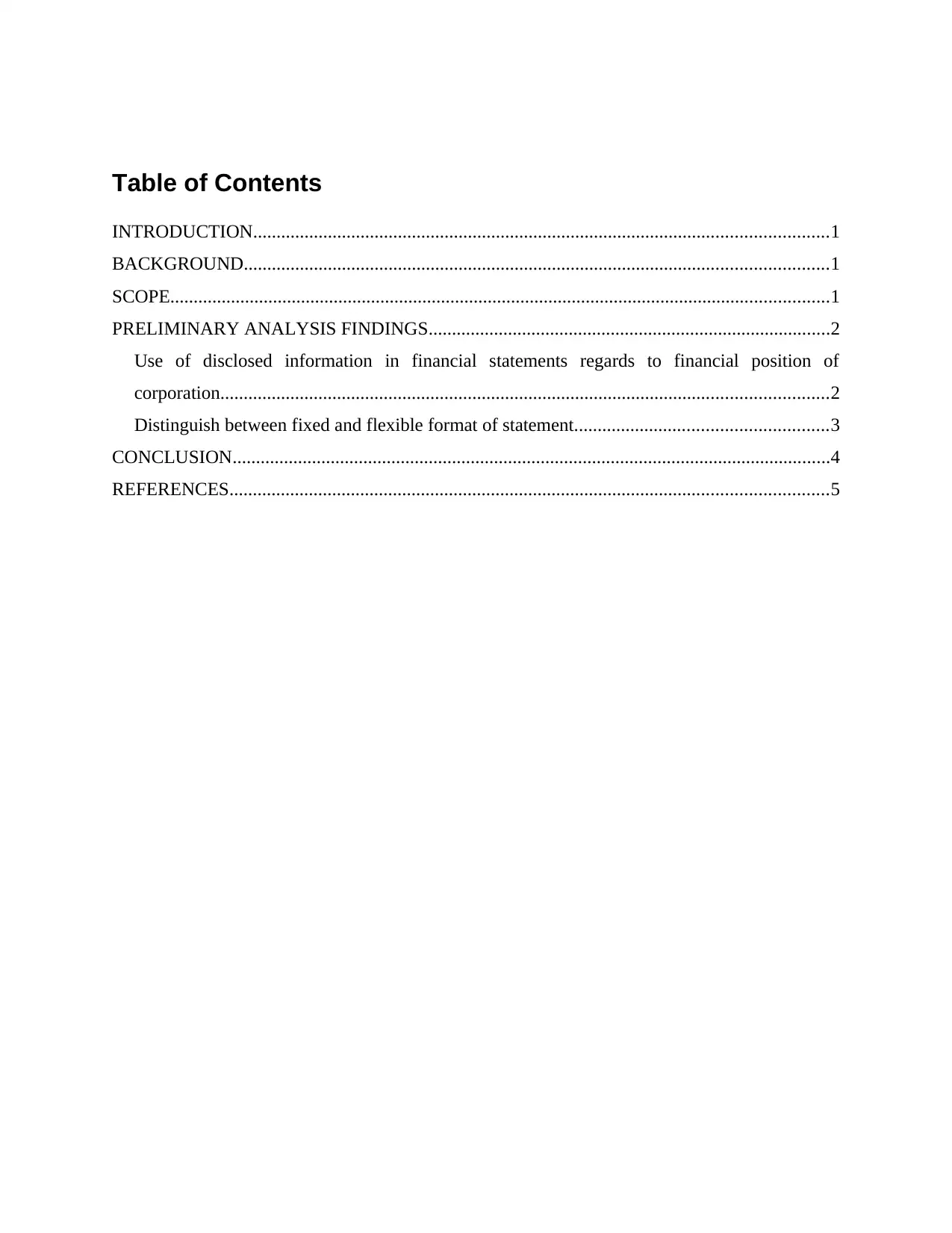
Table of Contents
INTRODUCTION...........................................................................................................................1
BACKGROUND.............................................................................................................................1
SCOPE.............................................................................................................................................1
PRELIMINARY ANALYSIS FINDINGS......................................................................................2
Use of disclosed information in financial statements regards to financial position of
corporation..................................................................................................................................2
Distinguish between fixed and flexible format of statement......................................................3
CONCLUSION................................................................................................................................4
REFERENCES................................................................................................................................5
INTRODUCTION...........................................................................................................................1
BACKGROUND.............................................................................................................................1
SCOPE.............................................................................................................................................1
PRELIMINARY ANALYSIS FINDINGS......................................................................................2
Use of disclosed information in financial statements regards to financial position of
corporation..................................................................................................................................2
Distinguish between fixed and flexible format of statement......................................................3
CONCLUSION................................................................................................................................4
REFERENCES................................................................................................................................5
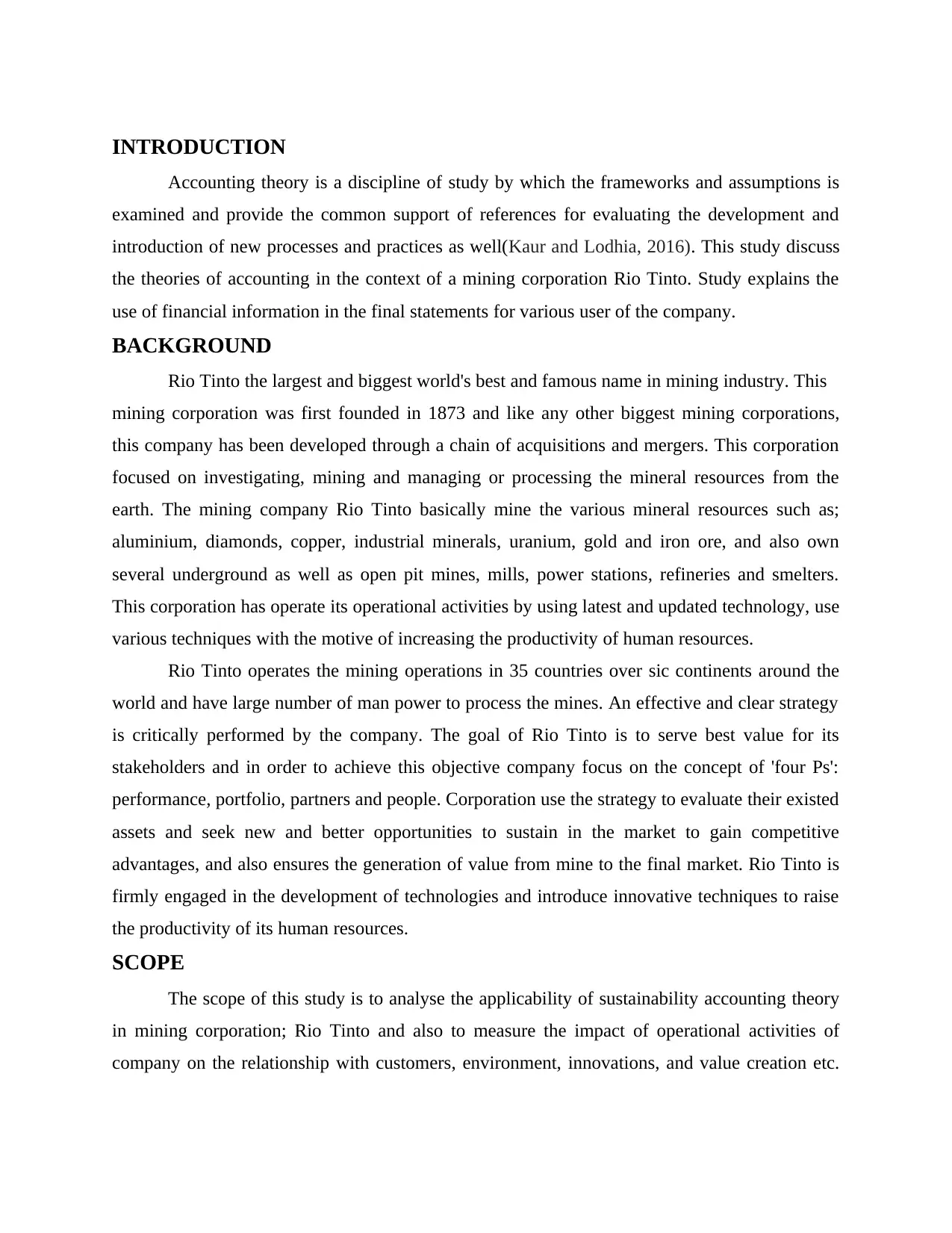
INTRODUCTION
Accounting theory is a discipline of study by which the frameworks and assumptions is
examined and provide the common support of references for evaluating the development and
introduction of new processes and practices as well(Kaur and Lodhia, 2016). This study discuss
the theories of accounting in the context of a mining corporation Rio Tinto. Study explains the
use of financial information in the final statements for various user of the company.
BACKGROUND
Rio Tinto the largest and biggest world's best and famous name in mining industry. This
mining corporation was first founded in 1873 and like any other biggest mining corporations,
this company has been developed through a chain of acquisitions and mergers. This corporation
focused on investigating, mining and managing or processing the mineral resources from the
earth. The mining company Rio Tinto basically mine the various mineral resources such as;
aluminium, diamonds, copper, industrial minerals, uranium, gold and iron ore, and also own
several underground as well as open pit mines, mills, power stations, refineries and smelters.
This corporation has operate its operational activities by using latest and updated technology, use
various techniques with the motive of increasing the productivity of human resources.
Rio Tinto operates the mining operations in 35 countries over sic continents around the
world and have large number of man power to process the mines. An effective and clear strategy
is critically performed by the company. The goal of Rio Tinto is to serve best value for its
stakeholders and in order to achieve this objective company focus on the concept of 'four Ps':
performance, portfolio, partners and people. Corporation use the strategy to evaluate their existed
assets and seek new and better opportunities to sustain in the market to gain competitive
advantages, and also ensures the generation of value from mine to the final market. Rio Tinto is
firmly engaged in the development of technologies and introduce innovative techniques to raise
the productivity of its human resources.
SCOPE
The scope of this study is to analyse the applicability of sustainability accounting theory
in mining corporation; Rio Tinto and also to measure the impact of operational activities of
company on the relationship with customers, environment, innovations, and value creation etc.
Accounting theory is a discipline of study by which the frameworks and assumptions is
examined and provide the common support of references for evaluating the development and
introduction of new processes and practices as well(Kaur and Lodhia, 2016). This study discuss
the theories of accounting in the context of a mining corporation Rio Tinto. Study explains the
use of financial information in the final statements for various user of the company.
BACKGROUND
Rio Tinto the largest and biggest world's best and famous name in mining industry. This
mining corporation was first founded in 1873 and like any other biggest mining corporations,
this company has been developed through a chain of acquisitions and mergers. This corporation
focused on investigating, mining and managing or processing the mineral resources from the
earth. The mining company Rio Tinto basically mine the various mineral resources such as;
aluminium, diamonds, copper, industrial minerals, uranium, gold and iron ore, and also own
several underground as well as open pit mines, mills, power stations, refineries and smelters.
This corporation has operate its operational activities by using latest and updated technology, use
various techniques with the motive of increasing the productivity of human resources.
Rio Tinto operates the mining operations in 35 countries over sic continents around the
world and have large number of man power to process the mines. An effective and clear strategy
is critically performed by the company. The goal of Rio Tinto is to serve best value for its
stakeholders and in order to achieve this objective company focus on the concept of 'four Ps':
performance, portfolio, partners and people. Corporation use the strategy to evaluate their existed
assets and seek new and better opportunities to sustain in the market to gain competitive
advantages, and also ensures the generation of value from mine to the final market. Rio Tinto is
firmly engaged in the development of technologies and introduce innovative techniques to raise
the productivity of its human resources.
SCOPE
The scope of this study is to analyse the applicability of sustainability accounting theory
in mining corporation; Rio Tinto and also to measure the impact of operational activities of
company on the relationship with customers, environment, innovations, and value creation etc.
⊘ This is a preview!⊘
Do you want full access?
Subscribe today to unlock all pages.

Trusted by 1+ million students worldwide
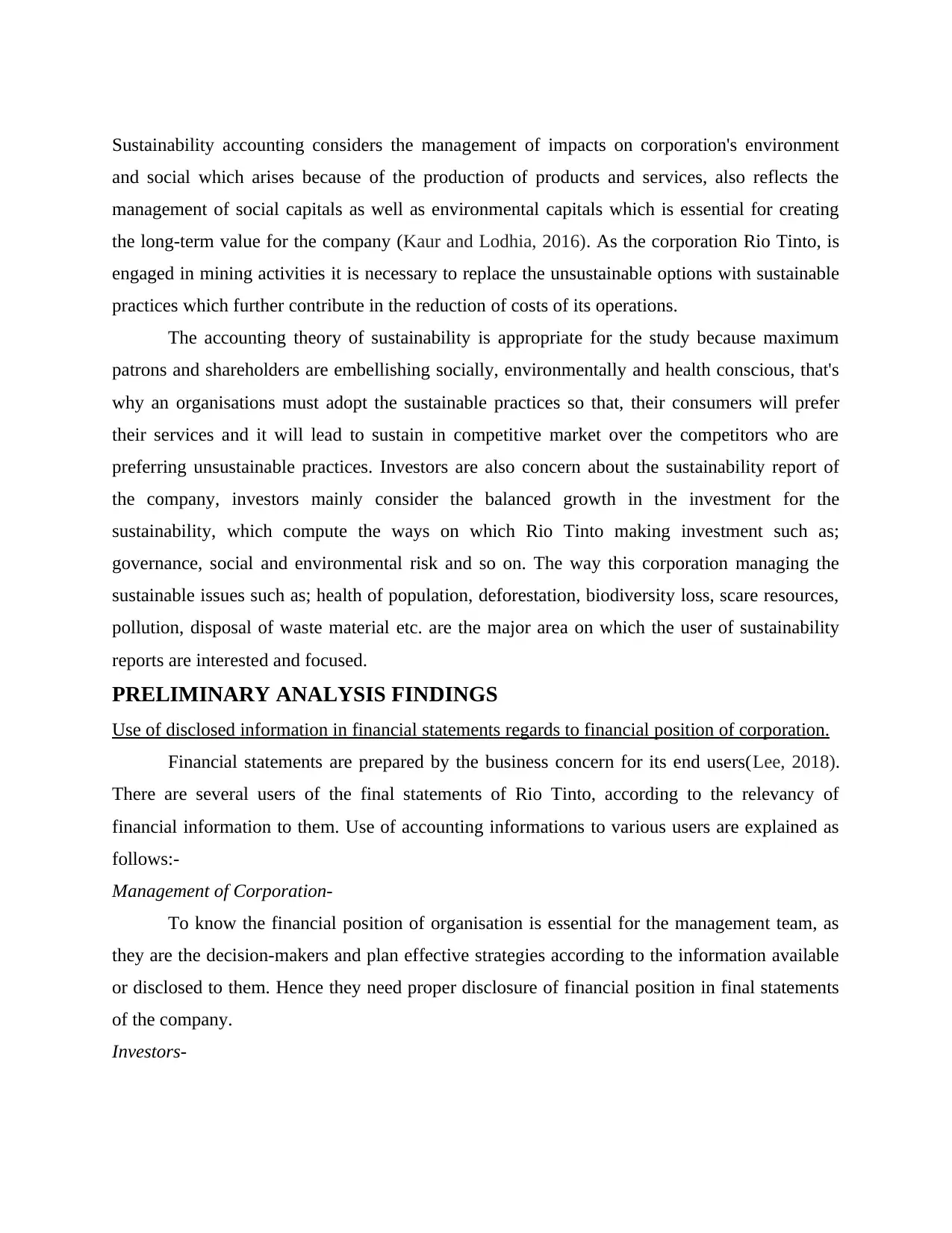
Sustainability accounting considers the management of impacts on corporation's environment
and social which arises because of the production of products and services, also reflects the
management of social capitals as well as environmental capitals which is essential for creating
the long-term value for the company (Kaur and Lodhia, 2016). As the corporation Rio Tinto, is
engaged in mining activities it is necessary to replace the unsustainable options with sustainable
practices which further contribute in the reduction of costs of its operations.
The accounting theory of sustainability is appropriate for the study because maximum
patrons and shareholders are embellishing socially, environmentally and health conscious, that's
why an organisations must adopt the sustainable practices so that, their consumers will prefer
their services and it will lead to sustain in competitive market over the competitors who are
preferring unsustainable practices. Investors are also concern about the sustainability report of
the company, investors mainly consider the balanced growth in the investment for the
sustainability, which compute the ways on which Rio Tinto making investment such as;
governance, social and environmental risk and so on. The way this corporation managing the
sustainable issues such as; health of population, deforestation, biodiversity loss, scare resources,
pollution, disposal of waste material etc. are the major area on which the user of sustainability
reports are interested and focused.
PRELIMINARY ANALYSIS FINDINGS
Use of disclosed information in financial statements regards to financial position of corporation.
Financial statements are prepared by the business concern for its end users(Lee, 2018).
There are several users of the final statements of Rio Tinto, according to the relevancy of
financial information to them. Use of accounting informations to various users are explained as
follows:-
Management of Corporation-
To know the financial position of organisation is essential for the management team, as
they are the decision-makers and plan effective strategies according to the information available
or disclosed to them. Hence they need proper disclosure of financial position in final statements
of the company.
Investors-
and social which arises because of the production of products and services, also reflects the
management of social capitals as well as environmental capitals which is essential for creating
the long-term value for the company (Kaur and Lodhia, 2016). As the corporation Rio Tinto, is
engaged in mining activities it is necessary to replace the unsustainable options with sustainable
practices which further contribute in the reduction of costs of its operations.
The accounting theory of sustainability is appropriate for the study because maximum
patrons and shareholders are embellishing socially, environmentally and health conscious, that's
why an organisations must adopt the sustainable practices so that, their consumers will prefer
their services and it will lead to sustain in competitive market over the competitors who are
preferring unsustainable practices. Investors are also concern about the sustainability report of
the company, investors mainly consider the balanced growth in the investment for the
sustainability, which compute the ways on which Rio Tinto making investment such as;
governance, social and environmental risk and so on. The way this corporation managing the
sustainable issues such as; health of population, deforestation, biodiversity loss, scare resources,
pollution, disposal of waste material etc. are the major area on which the user of sustainability
reports are interested and focused.
PRELIMINARY ANALYSIS FINDINGS
Use of disclosed information in financial statements regards to financial position of corporation.
Financial statements are prepared by the business concern for its end users(Lee, 2018).
There are several users of the final statements of Rio Tinto, according to the relevancy of
financial information to them. Use of accounting informations to various users are explained as
follows:-
Management of Corporation-
To know the financial position of organisation is essential for the management team, as
they are the decision-makers and plan effective strategies according to the information available
or disclosed to them. Hence they need proper disclosure of financial position in final statements
of the company.
Investors-
Paraphrase This Document
Need a fresh take? Get an instant paraphrase of this document with our AI Paraphraser
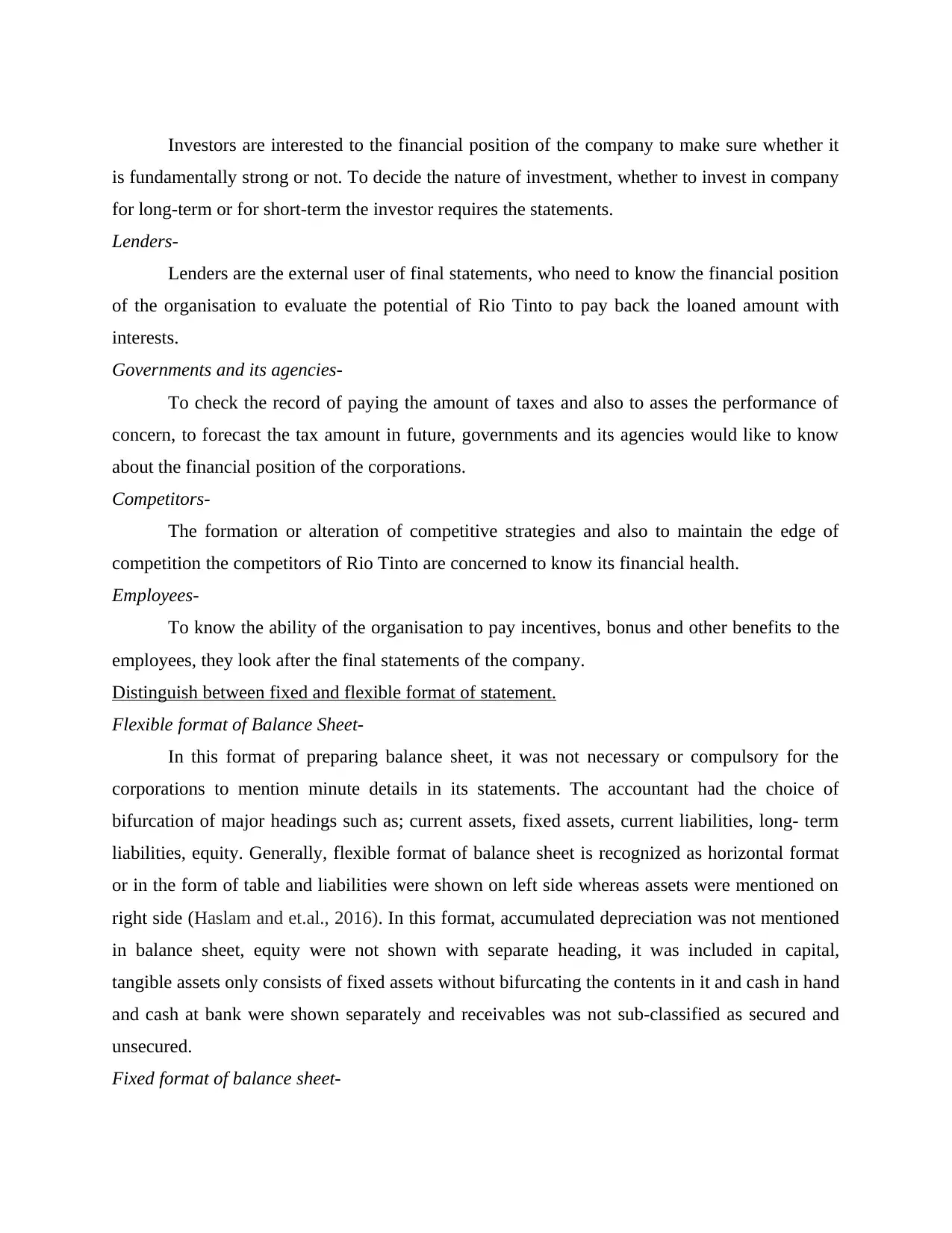
Investors are interested to the financial position of the company to make sure whether it
is fundamentally strong or not. To decide the nature of investment, whether to invest in company
for long-term or for short-term the investor requires the statements.
Lenders-
Lenders are the external user of final statements, who need to know the financial position
of the organisation to evaluate the potential of Rio Tinto to pay back the loaned amount with
interests.
Governments and its agencies-
To check the record of paying the amount of taxes and also to asses the performance of
concern, to forecast the tax amount in future, governments and its agencies would like to know
about the financial position of the corporations.
Competitors-
The formation or alteration of competitive strategies and also to maintain the edge of
competition the competitors of Rio Tinto are concerned to know its financial health.
Employees-
To know the ability of the organisation to pay incentives, bonus and other benefits to the
employees, they look after the final statements of the company.
Distinguish between fixed and flexible format of statement.
Flexible format of Balance Sheet-
In this format of preparing balance sheet, it was not necessary or compulsory for the
corporations to mention minute details in its statements. The accountant had the choice of
bifurcation of major headings such as; current assets, fixed assets, current liabilities, long- term
liabilities, equity. Generally, flexible format of balance sheet is recognized as horizontal format
or in the form of table and liabilities were shown on left side whereas assets were mentioned on
right side (Haslam and et.al., 2016). In this format, accumulated depreciation was not mentioned
in balance sheet, equity were not shown with separate heading, it was included in capital,
tangible assets only consists of fixed assets without bifurcating the contents in it and cash in hand
and cash at bank were shown separately and receivables was not sub-classified as secured and
unsecured.
Fixed format of balance sheet-
is fundamentally strong or not. To decide the nature of investment, whether to invest in company
for long-term or for short-term the investor requires the statements.
Lenders-
Lenders are the external user of final statements, who need to know the financial position
of the organisation to evaluate the potential of Rio Tinto to pay back the loaned amount with
interests.
Governments and its agencies-
To check the record of paying the amount of taxes and also to asses the performance of
concern, to forecast the tax amount in future, governments and its agencies would like to know
about the financial position of the corporations.
Competitors-
The formation or alteration of competitive strategies and also to maintain the edge of
competition the competitors of Rio Tinto are concerned to know its financial health.
Employees-
To know the ability of the organisation to pay incentives, bonus and other benefits to the
employees, they look after the final statements of the company.
Distinguish between fixed and flexible format of statement.
Flexible format of Balance Sheet-
In this format of preparing balance sheet, it was not necessary or compulsory for the
corporations to mention minute details in its statements. The accountant had the choice of
bifurcation of major headings such as; current assets, fixed assets, current liabilities, long- term
liabilities, equity. Generally, flexible format of balance sheet is recognized as horizontal format
or in the form of table and liabilities were shown on left side whereas assets were mentioned on
right side (Haslam and et.al., 2016). In this format, accumulated depreciation was not mentioned
in balance sheet, equity were not shown with separate heading, it was included in capital,
tangible assets only consists of fixed assets without bifurcating the contents in it and cash in hand
and cash at bank were shown separately and receivables was not sub-classified as secured and
unsecured.
Fixed format of balance sheet-
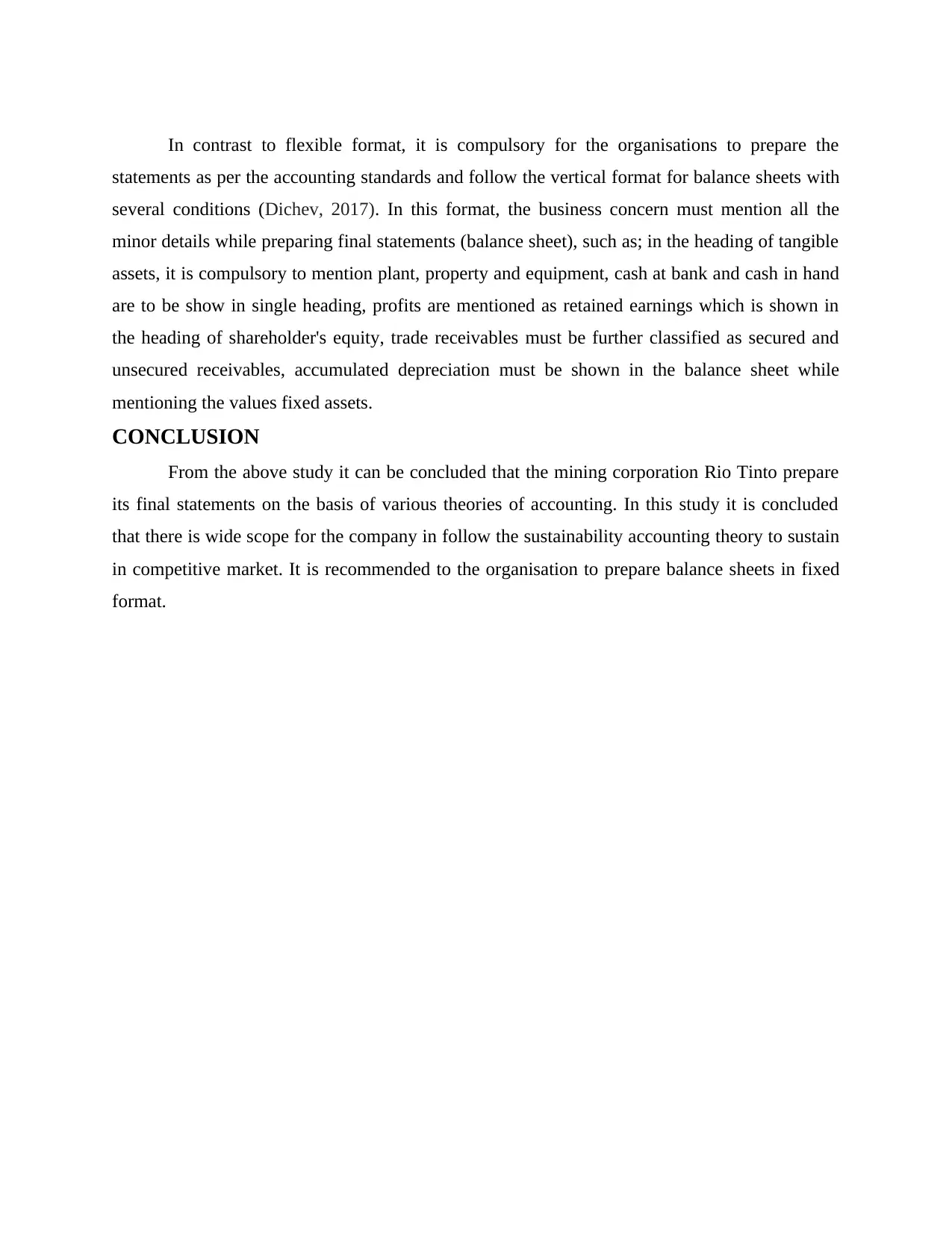
In contrast to flexible format, it is compulsory for the organisations to prepare the
statements as per the accounting standards and follow the vertical format for balance sheets with
several conditions (Dichev, 2017). In this format, the business concern must mention all the
minor details while preparing final statements (balance sheet), such as; in the heading of tangible
assets, it is compulsory to mention plant, property and equipment, cash at bank and cash in hand
are to be show in single heading, profits are mentioned as retained earnings which is shown in
the heading of shareholder's equity, trade receivables must be further classified as secured and
unsecured receivables, accumulated depreciation must be shown in the balance sheet while
mentioning the values fixed assets.
CONCLUSION
From the above study it can be concluded that the mining corporation Rio Tinto prepare
its final statements on the basis of various theories of accounting. In this study it is concluded
that there is wide scope for the company in follow the sustainability accounting theory to sustain
in competitive market. It is recommended to the organisation to prepare balance sheets in fixed
format.
statements as per the accounting standards and follow the vertical format for balance sheets with
several conditions (Dichev, 2017). In this format, the business concern must mention all the
minor details while preparing final statements (balance sheet), such as; in the heading of tangible
assets, it is compulsory to mention plant, property and equipment, cash at bank and cash in hand
are to be show in single heading, profits are mentioned as retained earnings which is shown in
the heading of shareholder's equity, trade receivables must be further classified as secured and
unsecured receivables, accumulated depreciation must be shown in the balance sheet while
mentioning the values fixed assets.
CONCLUSION
From the above study it can be concluded that the mining corporation Rio Tinto prepare
its final statements on the basis of various theories of accounting. In this study it is concluded
that there is wide scope for the company in follow the sustainability accounting theory to sustain
in competitive market. It is recommended to the organisation to prepare balance sheets in fixed
format.
⊘ This is a preview!⊘
Do you want full access?
Subscribe today to unlock all pages.

Trusted by 1+ million students worldwide
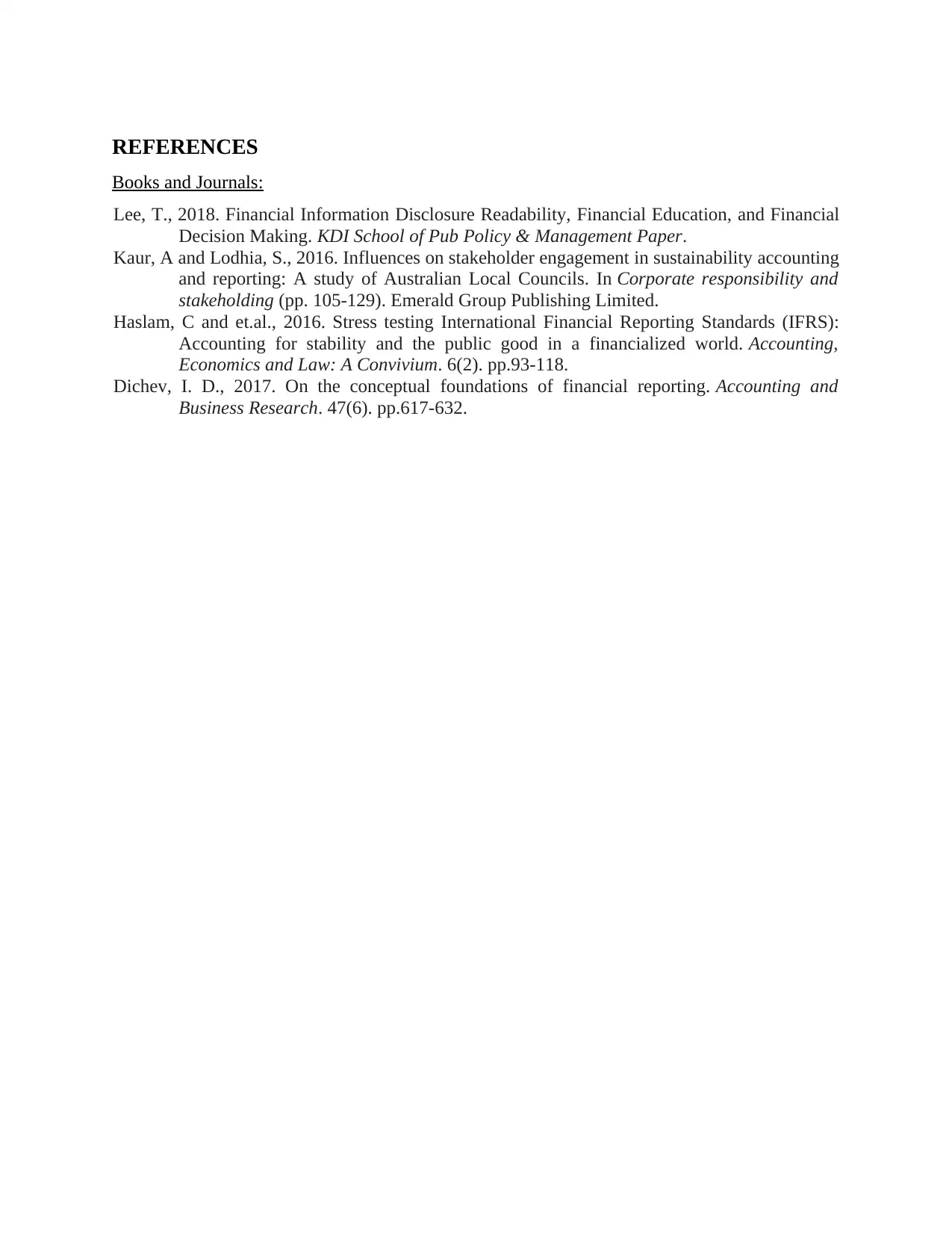
REFERENCES
Books and Journals:
Lee, T., 2018. Financial Information Disclosure Readability, Financial Education, and Financial
Decision Making. KDI School of Pub Policy & Management Paper.
Kaur, A and Lodhia, S., 2016. Influences on stakeholder engagement in sustainability accounting
and reporting: A study of Australian Local Councils. In Corporate responsibility and
stakeholding (pp. 105-129). Emerald Group Publishing Limited.
Haslam, C and et.al., 2016. Stress testing International Financial Reporting Standards (IFRS):
Accounting for stability and the public good in a financialized world. Accounting,
Economics and Law: A Convivium. 6(2). pp.93-118.
Dichev, I. D., 2017. On the conceptual foundations of financial reporting. Accounting and
Business Research. 47(6). pp.617-632.
Books and Journals:
Lee, T., 2018. Financial Information Disclosure Readability, Financial Education, and Financial
Decision Making. KDI School of Pub Policy & Management Paper.
Kaur, A and Lodhia, S., 2016. Influences on stakeholder engagement in sustainability accounting
and reporting: A study of Australian Local Councils. In Corporate responsibility and
stakeholding (pp. 105-129). Emerald Group Publishing Limited.
Haslam, C and et.al., 2016. Stress testing International Financial Reporting Standards (IFRS):
Accounting for stability and the public good in a financialized world. Accounting,
Economics and Law: A Convivium. 6(2). pp.93-118.
Dichev, I. D., 2017. On the conceptual foundations of financial reporting. Accounting and
Business Research. 47(6). pp.617-632.
1 out of 7
Related Documents
Your All-in-One AI-Powered Toolkit for Academic Success.
+13062052269
info@desklib.com
Available 24*7 on WhatsApp / Email
![[object Object]](/_next/static/media/star-bottom.7253800d.svg)
Unlock your academic potential
Copyright © 2020–2025 A2Z Services. All Rights Reserved. Developed and managed by ZUCOL.



